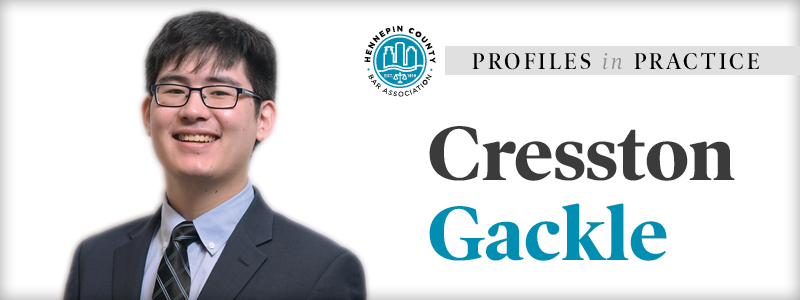
For Cresston Gackle, starting his own firm was a risk. But it was a risk he knew he had to take.
Gackle, a native of Bettendorf, Iowa, knew he wanted to be an attorney for a long time. “I originally had the idea in high school when I was involved in the debate program,” he said. “It wasn’t until college that I really decided on it. The paths out of a political science program are pretty straightforward, and, of those, law was the best fit. I viewed it then, as I do now, as the most substantive, direct, and practical way to help people and change things.”
After graduating from law school in 2016, Gackle clerked for a district court judge for three years, “A long time,” he noted. When it came time to decide what was next, he faced “one of the most difficult decisions of my life.”
“I thought about it for a full year,” he said. “I had a business plan, and I revised and edited it many times, I talked about it with a lot of people, and, ultimately, I made the leap. The decisive factor was that I needed and wanted a little more control over my clients and cases than I thought I would get at a firm.”
“There were a few people in my life who thought it was a fine idea, and several more people who thought it was a crazy idea—never to be tried,” he added with a laugh.
More certain than the idea of starting his own firm was the idea of what kind of law he wanted to practice.
“I found the area of law that I really wanted to practice while I was a student attorney at the University of Minnesota Child Advocacy and Juvenile Justice Clinic. Child-related law, whether family or juvenile, struck me as the most important area of law because these cases not only affect how kids’ lives are going but also these cases reverberate throughout their lives.”
Practicing on his own has had its own obstacles. Like most attorneys, Gackle said finding the right work-life balance is a perennial challenge.
 “Attorneys and would-be attorneys from diverse backgrounds not only need mentorship and a pathway to the law but also they need to be asked, ‘What can we do to make this better?’”
“Attorneys and would-be attorneys from diverse backgrounds not only need mentorship and a pathway to the law but also they need to be asked, ‘What can we do to make this better?’”
“If I don’t set boundaries, no one will,” he said. “It’s hard, but I have to acknowledge for myself that sometimes I don’t have the ability to do what’s asked by clients, potential clients, and courts. I try very hard to maintain at least some open time, and it doesn’t always work out, but I’m setting regular vacation time and I’m not compromising on that. To maintain my quality of work product and maintain my ability to be a strong advocate, I have to reserve a little time to myself.”
The emotionally charged nature of Gackle’s work—child protection, visitation, custody matters, and other family law issues— can be taxing.
“There have been many cases that have kept me up at night, when I couldn’t stop thinking about them or couldn’t cool down as quickly as I wanted to,” Gackle said. “I think two things help me. One is that there has to be a boundary, and for me, that boundary is I am going to do everything to help this person and work with all the legal mechanisms I can, but ultimately, I am not going to live that person’s life. Two is that many times in family court and especially in juvenile court, a lot of people are working together—from the bench to guardians ad litem to social workers to parent attorneys and child attorneys— to repair the family system. It can be contentious, but I make my best contribution, and I try to remember that others are making their best contributions, too.”
That confidence in the legal system has served him well.
“We, as lawyers, are trained to make the very best arguments we can, and that can temporarily bring us into conflict with each other,” he said. “But the ultimate goal is fairly clear in juvenile court—to return things in a safe way with as minimal court involvement as possible to the way things were.”
Faith in the legal system, though, doesn’t mean Gackle doesn’t see things that can and should change. One of those things is diversity and representation, an area where Gackle joins the chorus of voices saying change is encouraging, but too slow in coming.
“If it is changing, it is unfortunately not changing fast enough,” he said. “We knew this was a problem 30 years ago. We knew this was a problem, frankly, 50 or 60 years ago. Under-representation on the bar and the bench is horrendous. There are some initiatives that are small, but are gaining traction. The prison-to-law-school pipeline program is promising. Twin Cities Diversity in Practice is doing some excellent work. But right now, these efforts seem small compared to the magnitude of the problem. Attorneys and would-be attorneys from diverse backgrounds not only need mentorship and a pathway to the law but also they need to be asked, ‘What can we do to make this better?’”
“And they need to be asked every step of the way, from initial interest to 1L summer to first law job through the next. Otherwise, our profession will continue to provide ladders for some and chutes for others.”
 By Will Ashenmacher
ashenmacherw@ballardspahr.com
By Will Ashenmacher
ashenmacherw@ballardspahr.com
Will Ashenmacher is a licensed attorney, former journalist, and communications manager in the Minneapolis office of Ballard Spahr. In his role, he works across the national firm’s seven Western offices to find and further stories about Ballard Spahr’s attorneys, work matters, and firm culture. Will volunteers with the University of St. Thomas’ ThreeSixty Journalism program. He lives in the Longfellow neighborhood of Minneapolis with his dog, Kitsu.